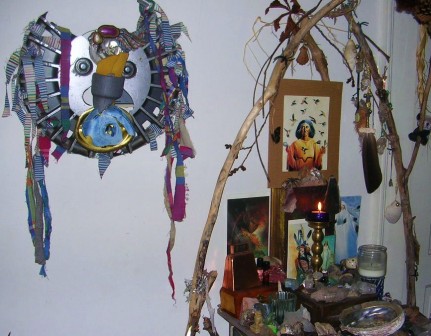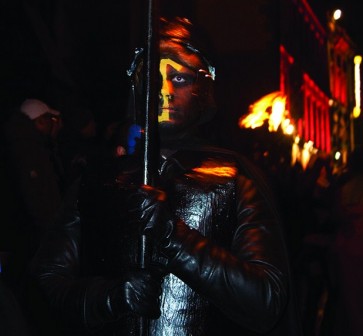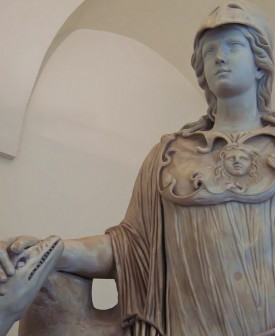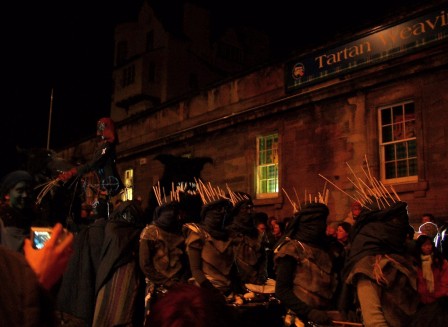Halloween: Paganism Celebrates The Forgotten Divine Feminine
By Kit Kimberly
As Halloween approaches, images of kids in costume, of Linus waiting for his Great Pumpkin, of ghosts and ghouls, the street decorations and signs of autumn fill the pop culture consciousness — at least in the USA and some other Euro-based cultures. In the US this year, All Hallows also falls on the eve of an election — with possibly scary consequences for all!
But as witch and pagan scholar Starhawk recently pointed out in her Washington Post column , Senate candidate Christine O’Donnell and others greatly misunderstand these ancient traditions. A self-proclaimed feminist, Ms O’Donnell’s ignorance about the religion she claimed to have “dabbled” in is a shame: This religious mythology has much to offer women.
Founded in Samhain (pronounced sow-an, meaning “summer’s end”), Halloween comes from the Anglo-Keltic tradition and marks the end of the growing year and harvest, the beginning of winter. It is a time for ridding society of the old, raising bonfires, recognizing the end of the old year in preparation for the new. Other cultures celebrate the Day of the Dead (Mexico), Martinisingen (Germanic cultures), and the tradition of Qarqe’an (Arabic). Christian churches also recognise it as All Hallow’s Eve, the day before All Saint’s Day.
US Americans and others celebrate via (now often commercialized) rituals of popular culture and contemporary religion, but few acknowledge the ancient traditions behind them. Pre-patriarchal, nature-based pagan cultures established festivals to correspond to the seasons of the year. With Samhain comes the death of the Horned God, the symbol of fertility, who has been feted and blessed with the best of the harvest, the most comfortable place, the highest quality poetry, singing and dance, and the most fertile of females — including the Goddess herself — to ensure the fertility of the land and success of the harvest.
He must die, to be born again in Spring. If he does not, as T. S. Eliot describes in “The Wasteland”, the Earth becomes barren, no longer thrives to share its bounty with humanity.
The idea of a god who is born to die and be resurrected is not unfamiliar to the Judeo-Christian tradition. Indeed, the Christian church did not, as my grandmother so acerbically observed, “pick it up off the streets.” Nor was the idea of a god coming down from the heavens (Olympus, Asgard, Avalon) to mate with a human woman anything new: One of the greatest Greek myths has its foundations in the story of Leda, who was raped by Zeus in the form of a swan. In every sacred Judeo-Christian rite or belief can be found seeds of pagan mythology. While successful in demonizing and eradicating much of the pagan belief systems and traditions behind them, the Christian forefathers were not particularly original.
The term pagan can be used in a number of different contexts; the most narrow defines all religions and mythologies not based in or stemming from the Abrahamic traditions of Judeo-Christianity and Islam (including Buddhism and Hinduism, both of which are older than Christianity and practiced by more people) as “pagan”.
For the context of this article, however, the term paganism refers to Anglo-Keltic-based mythologies/religions. These manifest today in the forms of Wicca, witchcraft and generic or “neo-pagan” adherents. Some follow the Gardenerian tradition, based in the studies and book of Gerald Gardener which are somewhat rigid — some might even say patriarchal — in their interpretations. Others look to more progressive philosophers such as Starhawk, whose books over the years and columns for The Washington Post have helped to dispel some of the myths and clarify the position of thousands of hedge witches and other pagans throughout the US and Western world.
Unlike the patriarchal, monotheistic “major world” religions prevalent today, Goddess-based paganism recognizes the equal value of the feminine. At the center of this mythos is the concept of the Divine Feminine as well as a Divine Masculine. Neither dominates the other; indeed, the concept of hierarchical values, of one gender (one species, one type of life form) dominating another is the essence of patriarchy. It has no place in nature-based religions.
Nor does the concept of suffering for one’s sins. In this pagan belief system, there is no dualistic “good vs evil”. Evil does not exist as a separate entity — it is a creation of Judeo-Christianity, of patriarchy, to provide a “stick” with which to intimidate and control a recalcitrant population. Even some Christian philosophies reflect a similar tenet: To paraphrase St. Augustine (354 –430 CE), “All that God creates is good; the only evil is in not choosing the greatest good”.
On the contrary, the pagan traditions focus on pleasure — the “carrot” — as a means of integrating the individual into the community and solidifying the whole. This desire for (this pursuit of) pleasure is the basis for much of pagan ritual. Samhain festivals include candle-lit parades of thousands costumed to represent iconic pagan figures such as the God and Goddess, harvest deities, and the dead. Despite their solemnity (Who says pleasurable activities cannot also be serious?), these rites can engender a profound sense of connectedness to community as well as the Earth. The other major cross-quarter festival, Beltane, comes at the beginning of the fertile season; all are encouraged to eat and drink of the new growth, of Spring lambs and wine; but most especially to engage in an orgiastic pursuit of sexual pleasure to ensure a fertile growing season. It is here that the young Horned God meets and mates with the eternal Goddess: She comes to us as Demeter, Medusa, Hecate, Isis; the Kelts give us The Morrighan, Dagda and Kerridwen; his randiness recognized in the Roman Bacchus, the Greek Pan or Dionysus; in Kernunnos, Janicot, Dianus and Actaeon of the Anglo-Keltic tradition. It is he whom the Christians patriarchs—who well knew how difficult it is to control a people whose values and mythology are pleasure-based—transformed into Satan, the horned, hoofed anti-god, whose presence in one’s life ensured an eternity in hell.
How much easier to control through fear and punishment, fear of punishment? To ensure that the Church, the nobility and the monarchy, had first access to all of the best the land produced, the strongest warriors, the most fertile/beautiful women, the greatest art, the most valuable elements of the society. By providing a rigid set of rules and social structures, by demonizing all that was hedonistic and pleasurable about the “Old Religions”, and especially by degrading and debasing the feminine and female sexuality as depraved, wicked and immoral, the Christian patriarchs managed to create the hierarchical pyramid value system that exists throughout Western “civilization” today.
Yet every October 31 (based on the Gregorian calendar and not really accurate; these traditions began millennia ago and were based on moon cycles. Interestingly, the arguably most sacred of Christian festivals, Easter, still takes its timing not from contemporary calendars but from the ancient way of telling time: It is the first Sunday after the full moon of the spring equinox) we in Western society dip, often shallowly, but sometimes more deeply, into our hedonistic ancient myths, seeking perhaps to reconnect to that Earth, that land that was the very first victim (and remains most critical) of patriarchal domination.
On a personal level, however, can we not engage in Samhain as a cleansing of the old, a time to eliminate the unsound, unhealthy, less-than-valid ideas that have bogged down our progress? Perhaps even the current political paradigm could benefit from such a purge — in preparation for the fallow Winter. That way, we can emerge from the ritual as clean and empty vessels, ready to take on the challenges of the new season.
Editor’s Note: Kit Kimberly is a US-born expat who has lived in Prague, Czech Republic; the Highlands of Scotland; and Brisbane, Australia. Raised and educated in North Carolina, she has worked as a journalist, political activist, university lecturer and creative writer and editor for more than 20 years. Her writing has appeared in The Prague Post, The Sunday Mail, The European, Transitions, The Durham Morning Herald, and other international publications.
Related Articles

















You must be logged in to post a comment Login